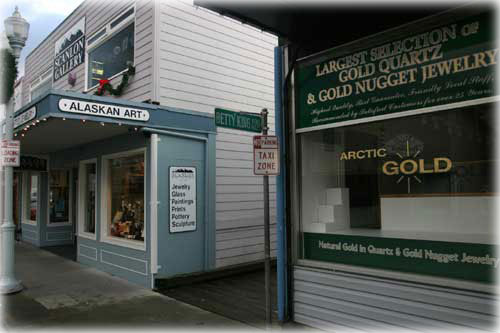 Betty King the Dog Lady Ketchikan's one-woman humane society By June Allen December 01, 2004
 Photo by Carl Thompson 2004
Betty King's wooden property
that served her as home and dog shelter - she owned it - may
have been the most curious piece of real estate in all of Ketchikan.
The whole length of the alley behind the dockside Front Street
businesses - and thereby behind the Main Street buildings as
well - is planked, in locations over tidewater. Betty's tiny
little two-story house and rough-cut plank yard was tucked into
a space behind the old Union Rooms on Mill Street, screened off
from the alley by a six-foot tall, gated plank fence that kept
the dogs in and nosy people out. (The Union Rooms building was
torn down recently and new commercial building erected at 319
Mill Street.) Betty King was born in Cleveland, Tennessee, on May 5, 1886. She saw herself as a true southern lady from the day she came to Ketchikan, and she expected to be treated with respect. She declined to talk to her chosen few friends about her years as a sporting woman, although it was common knowledge that she was involved in a long-standing feud with Dolly Arthur of Creek Street. Both women loved and raised dogs, and the friction may have started because of their pets.  Photo by Carl Thompson
Oldtimer Earl Fosse remembered
Betty as a nice looking woman, intelligent and well spoken. She
was, he said, a pretty woman when she was younger. He recalled
her coming into his shop one day for a stack robber for the stove
in her little house in the alley. She made it plain that she
didn't want him to come to her house, however, but one of his
employees could go in to install her stack robber. The workman
reported that it smelled very strongly of dogs! Betty paid off
her obligation to Fosse at $5 a month, with a gift of a bottle
of crËme de menthe at the end of her contract.
There are always those who snicker at eccentric people. But Ketchikan being what it is, everyone appreciated what Betty did. Downtown businessmen helped her in her new location, donating meat and other goods for her dogs and for herself. Dorothy Fosse at the Mode O Day gave Betty dresses. When the little house suffered a fire one winter, several downtown businessmen rebuilt it for her. Betty's husband Bergen died in 1960. Some years later Betty King fell ill after a minor stroke and found herself in the hospital. A fickle fate had somehow put her in a two-bed room with her old nemesis, Dolly Arthur! Being so close together, Mrs. Daigler said, the two elderly women resolved their differences and managed to become friends in the concluding years of their lives. Maybe the friction had been because both unconventional old women loved dogs more than they loved people. Betty King died alone in her little house in the alley in August of 1970, her dogs whining and baying. She was 84. Ketchikan Daily News reporter Bob Kinerk reported that word of Betty King's death reached the newspaper. Her dogs were said to be giving the people who came for her body a hard time! He grabbed his camera, thinking he'd get a comical shot of her body being carried out on a stretcher in the midst of a sea of howling dogs. What he actually got, he confessed, was his comeuppance for thinking of her as a joke. He wrote, "The first thing I thought when I got to her dwelling place was how neat and tidy it looked. The house itself was small and surrounded by a sturdy fence of two-by-fours and cattle wire. It certainly didn't look like a dog pound. It looked like someone cared about that dwelling." "The tipster's description of the trouble with the dogs was very accurate. Inside the yard a city worker with heavy boots and heavy gloves was trying to corral the animals, about a dozen of them, which were in a sort of frenzy and were probably very dangerous, he continued. With him was a woman I didn't recognize, but she looked like she had slipped into her coat and come straight from an office. She wore heels and nylons, and her hair was coiffured. Perhaps she was a social worker, or perhaps she was a friend. She was helping with the animals and appeared to be in greater danger from their excitement and fear than the more suitably dressed man." "It seemed to me," Kinerk's account continued, "that my question about the disposition of the body ought to be addressed to her, so as soon as I'd popped out of my car and reached the fence I said to her something like, 'Have they brought out the body yet?' The woman looked at me with so much venom that I wished the planks had parted and I'd plunged into the icy Narrows underneath." "I don't believe she swore at me, but she probably didn't have to. She said she didn't know what the newspaper, which never cared about Betty King when Betty King was living, meant by sending out a cameraman now that the poor woman was dead. I have a whole slew of answers to questions like that," Kinerk continued. "Most of them have to do with the public's right to know and so forth. None of them seemed appropriate among those frenzied dogs. I stood awhile looking penitent and hoping time would soften the woman's response. It didn't, however. She continued to glower. The dogs continued their leaping and barking." He got into his car and left. "The measure of my guilt in this is that whenever I saw her afterwards," he wrote, "I imagined she looked at me with hate, and the measure of my ignorance is that I never knew why I deserved it. Now, upon reflection, it seems to me quite plain. It seems her anger at me was intended to say that she was a person with a compassionate heart, and I was a person who lacked one." His story ended on a note of contrition. Betty King left the house and property to Gordon Zerbetz, the son of Jack Zerbetz, one of the businessmen who built the house for her. Gordon had the little house cleaned but no amount of cleaning would erase the doggy smell. So he had the very walls and floors removed and replaced with new construction. The little house may be gone by now? But the feral cats remain, their kittens peeking out from unexpected places in search of food. A number of cruise ship personnel discovered the cats and each year visit the alley to leave them scraps and treats. That alley just has heart. And today, all these years after Betty King's life came to an end, her biography is itself so obviously full of so many examples of compassion - within an appreciative civic and business community that freely provided her with a house and donations of many kinds; in the dog lovers who valued and trusted her, and in a citizenry that may have stared but still respected her and her dedication to the animals. That, after all, is Ketchikan.
Excerpts from Bob Kinerk's story courtesy of The Ketchikan Record 1990.
All rights reserved. Not to be reprinted in any form without the written permission of June Allen.
|






